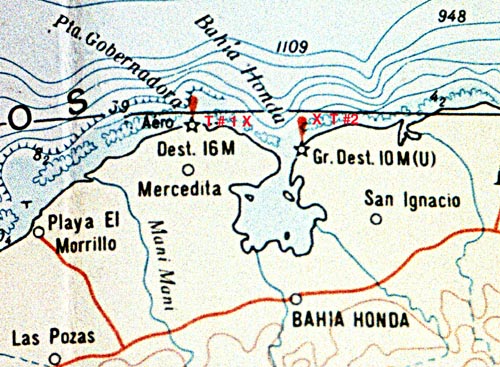

MAP of BAHIA HONDA
Index Of Bahia Honda

If the biota, in the course of aeons, has built something we like but do not understand, then who but a fool would discard seemingly useless parts? To keep every cog and wheel is the first precaution of intelligent tinkering. Aldo Leopold, Round River, 1993.
Reef Relief Founders.com
Bahia Honda is approximately 35 miles west of Havana and is the first bay that cruising boats traveling west from Havana are allowed to enter. The charts and cruising guides refer to many shallow areas along this north west coast as coral reefs and it appeared that coral was to be found just outside of the entrance to this bay. Bahia Honda is a rather large industrial bay where freighters and other large vessels are torn apart and recycled. This is also a port for loading dangerous cargoes, especially acids. The first snorkel of the expedition was conducted in an area called Ensenada de Las Salinas from a point at Punta del Morillo south to the guardia frontera post where we anchored (see chart). We did not record any video or take any still images on this first reconnaissance snorkel. There was no question that the water inside of the bay was much greener than the water immediately outside of the bay and that algal coverage increased upon entering the bay. On the outside of the bay, fairly healthy sea grass beds covered the Ensenada de las Salinas, yet there were no fish, conchs, or sea urchins. From this 200 meter snorkel we decided to record the first two video transects in front of the bay, one on the west side (T1) and the other on the east side (T2).
June 3, l998 Bahia Honda
The water depth in this area is about four feet in the deepest area and shoals to about two and a half feet. There was a very healthy sea grass field at the beginning of this snorkel on the outside of the bay however it was lacking lacking in fish and conch. We snorkeled from the fort toward the area where Stormy Weather was anchored. As we moved in toward the bay, algal blooms became prevalent: Sargassum helix and Chaetomorpha linum. It is very obvious that a nutrient overload is pulsing out of the bay as the water color changed dramatically from deep Gulf Stream blue from the entrance of the harbor to an opaque green on the inside, a distance of less than one mile.
June 4, l998 Bahia Honda transect #1
The first video transect was on a reef to the west of the entrance to the Bay. this area of very shallow water (6-10 feet) was located directly west of entrance buoy #2 which is identified on the chart. N 22 59.008 W 083 10 .065. This reef is subject to the majority of water flowing out of the bay due to the westerly set of the onshore current flowing westerly past the mouth of the bay. There were no sea urchins or fish of any size and macroalgae dominated this reef. Several fresh boat grounding scars were evident one of which smashed into the only healthy Diploria clivosa in the area. DeeVon discovered a fresh water senote with much cooler water on the reef. The few formations of Elkhorn coral that were present were dead. It was of little surprise to find algae dominating this reef considering Bahia Honda is a port where dangerous chemicals are transferred.
June 4, l998 Bahia Honda transect #2
Transect 2 was located on the east side of the entrance to the harbor. The area was very shallow and flat surrounded by sand and sea grass. There were very few large corals in the area, giving the impression that this area has always taken the brunt of heavy seas protecting the entrance to the bay. There was a wide diversity of small coral colonies, all of which were threatened by an abundance macroalgae. In both transect #1 and #2 there were no healthy sea fans. At T#2 two men in snorkel gear were spear fishing. This reef had a yellow turf dominating the bottom, similar to an algae that we saw growing on the shallow reefs near Negril, Jamaica in Long Bay.




